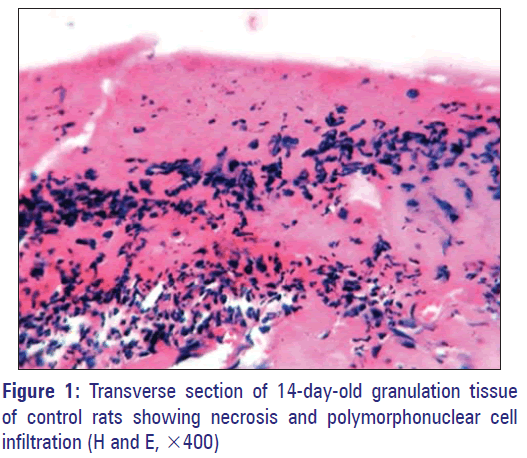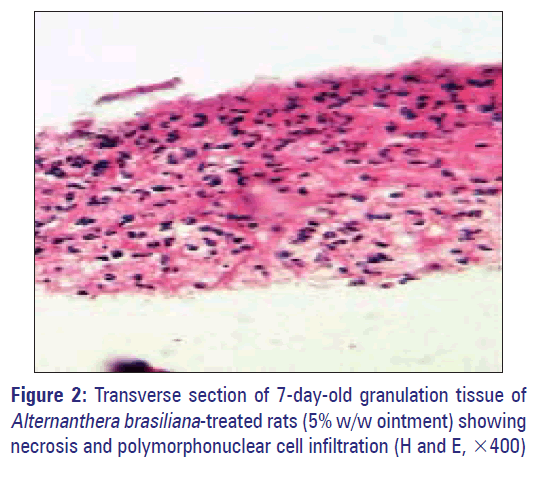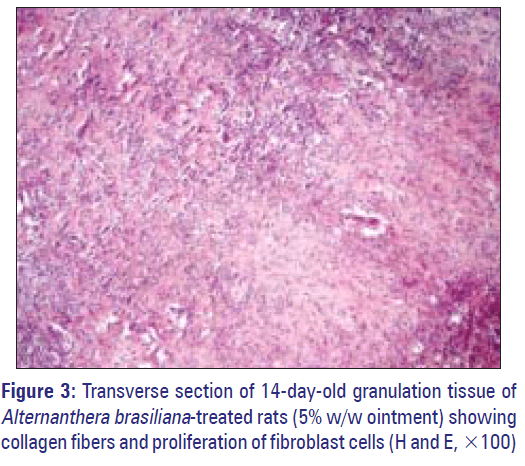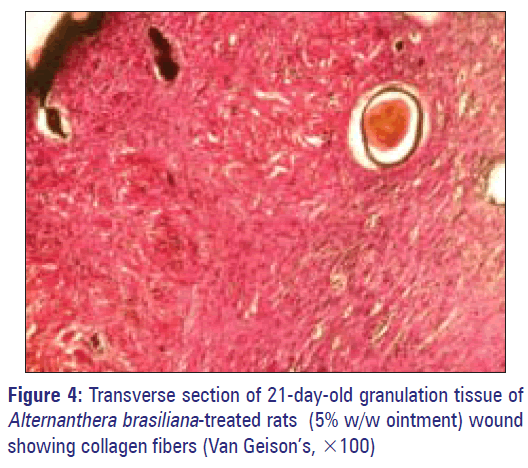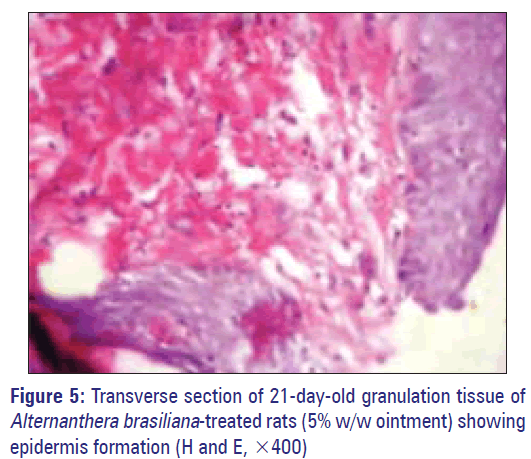Healing efficacy of methanol extract of leaves of Alternanthera brasiliana Kuntze in aged wound model
- *Corresponding Author:
- Dr. Chandana Choudhury Barua
Department of Pharmacology and Toxicology, College of Veterinary Science, Assam Agricultural University, Khanapara, Guwahati, Assam, India.
E-mail: chanacin@gmail.com
Abstract
The methanol extract of Alternanthera brasiliana Kuntze (Family: Amaranthaceae) leaf was investigated for its wound healing effect by excision wound model (in vivo) in aged Sprague Dawley rats. In excision wound model, compared to the control group, percent contraction of wound was significantly (P < 0.01) higher in A. brasiliana treated group (5% w/w ointment). The collagen, elastin, and hydroxyproline contents of the granulation tissue of A. brasiliana-treated group increased significantly (P < 0.01) compared to the control group, indicating better wound healing activity of the test plant. These fÂÂÂÂÂÂindings were also confÂÂÂÂÂÂirmed by histopathological examination. The results suggested that methanol extract of A. brasiliana possesses signifÂÂÂÂÂÂicant wound healing potential in aged animal wound model.
Keywords
Alternanthera brasiliana, excision wound, incision wound, wound healing
Introduction
Wound healing is a complex phenomenon that results in restoration of anatomic continuity and function, accomplished by several processes which involve different phases including inflammation, granulation, fibrogenesis, neo-vascularization, wound contraction, and epithelization.[1] The floral richness of the North-East region cannot be neglected in context to its medicinal importance. Considering the rich diversity of this region, it is expected that screening and scientific evaluation of plant extracts for their diverse activity may provide new drug molecule that can combat various side effects of the commercially available synthetic drugs, moreover reducing the cost of medication.
Alternanthera brasiliana Kuntze (Family: Amaranthaceae), an herbaceous plant commonly known in Brazil as Penicillin or Brazilian Joy Weed is a neotropical native species, which grows easily on poor and deforested soil. The plant is used against inflammation, cough, and diarrhea in Brazilian popular medicine.[2] The extracts of A. brasiliana exhibited anti-nociceptive effects in mice,[3] antimicrobial effect,[4] and also anti-herpes simplex virus activity.[5] Aqueous or ethanolic extracts of A. brasiliana are able to block human mitogen induced lymphocyte proliferation without any toxic effect.[6]
In our earlier study on the wound healing activity of A. brasiliana using excision and incision wound model (in vivo) in normal Sprague Dawley rats and in chorioallantoic membrane model (in vitro) in 9-day-old embryonated chicken eggs, promising wound healing activity was reported.[7] Therefore, this study investigates the healing efficacy of A. brasiliana in excision wound model in aged rats. Any type of wound takes longer to heal in aged individual due to their poor health condition combined with other age-related ailments than younger individual. Bed sore is also quite common in aged individual as they are bedridden due to various diseased conditions. This has prompted us to study the healing pattern in aged animals using the same plant extract which showed promising wound healing activity otherwise in other types of wounds, mainly excision, incision, diabetic, burn, or immunocompromised animals in order to compare the healing efficacy of the same plant in different types of wounds.
Materials and Methods
Plant material
The leaves of the plants were collected from the medicinal garden of the Department of Pharmacology, College of Veterinary Science, Khanapara during the month of Feb-June, 2010. It was identified by a Taxonomist Dr. Iswar Barua, Assam Agricultural University, Jorhat, Assam and a voucher specimen (AAU/CVSC/PHT/02) was deposited.
Preparation of methanol extract
Fresh leaves of the plant were cleaned from extraneous materials, washed, shade dried, powdered mechanically, weighed, and stored in airtight container. About 250 g of powdered material was soaked in 1000 ml methanol for 72 h in beaker and mixture was stirred every 18 h using a sterile glass rod. Filtrate was obtained three times with the help of Whatman filter paper no. 1 and the solvent was removed by rotary evaporator (Equitron, Roteva; Medica Instrument Mfg. Co, Mumbai, India.) under reduced pressure at <45ºC temperature leaving a dark brown residue. It was stored in airtight container at 4ºC until use. Recovery was 6.12% (w/w).
Phytochemical screening
The methanol extract of A. brasiliana was subjected to preliminary, qualitative, and phytochemical investi gations for the presence of various active principles as per standard method.[8]
Ointment preparation of A. brasiliana
Ointment of three different concentrations were prepared by mixing 2.5, 5, and 7.5 g of methanol extract of leaves of A. brasiliana with 97.5, 95, and 92.5 g of white soft petroleum jelly (S.D. Fine Chemicals, Mumbai, Maharastra, India) to prepare 2.5%, 5%, and 7.5% ointment (w/w), respectively.
Animals
Nineteen-month-old healthy Sprague Dawley rats of either sex, approximately of same age, weighing between 150-250 g were used for the study. They were housed under controlled conditions of temperature (25 ± 2oC), humidity (50 ± 5%), and 12:12 h light–dark cycles with food and water ad libitum. Animals were housed individually in polypropylene cages containing sterile paddy husk bedding. The experiments were performed as per guidelines of the Institutional Animal Ethical Committee (770/03/ac/CPCSEA/FVScAAU/IAEC/06/21) and conform to the national guidelines on the care and use of laboratory animals, India. Animals were periodically weighed before and after experiments. All the animals were closely observed for any infection and those which showed signs of infection were separated and excluded from the study.
Determination of LD50 and acute toxicity
The lethal dose (LD50) of A. brasiliana was estimated by following up-and-down stair case method in mice using Organization of Economic Co-operation and Development (OECD) TG-425 guidelines. Doses were adjusted by a constant multiplication factor viz., 4 for this experiment. The dose for each successive animal was adjusted depending on the previous outcome. The acute toxicity and gross effect of crude methanolic extract of A. brasiliana were studied in albino mice using 1/2 LD50 (Lethal dose) dose. A total of six numbers of male albino mice were selected for each experiment. Animals were observed hourly for 6 h and again after 24 h. The parameters for motor activity and gross effect were determined after administration of A. brasiliana orally at a dose of 2 g/kg body weight.
In vivo model
One model for in vivo wound healing activity was tried in this study viz., excision wound model. The animals were randomly allocated into three groups of six animals each. Group I was assigned as control, Group II received topical application of 5% ointment of A. brasiliana (w/w).
Excision wound model in aged rat
The excision wounds were made by excising the full thickness circular skin (~500 mm2) on the back of the animal under ether anesthesia.[9] Wound contraction was assessed by tracing the wound area on polythene paper first and subsequently transferred to 1 mm2 graph sheet from which the wound surface area was evaluated on days 7, 14, and 21. The evaluated surface area was then employed to calculate the percentage of wound contraction (taking the initial size of the wound, 500 mm2, as 100%) by using the formula
[(Initial wound size−specific day wound size)/Initial wound size] × 100.
Experimental design
A preliminary study was conducted for selection of the most effective concentration of methanol extract of A. brasiliana ointment by using 2.5%, 5%, and 7.5% (w/w) ointment for topical application. As 5% (w/w) ointment showed optimum wound healing activity, it was selected for further detail study. The experimental animals (rats) were randomly allocated into three groups of six animals each. Group I served as control and the rats received topical application of the vehicle, i.e., soft white petroleum jelly, twice daily from day 1 till day of complete healing or 21st post-operative day, whichever was earlier. Animals of Groups II received topical application of 5% (w/w) ointment of A. brasiliana twice daily from day 1 till day of complete healing or 21st post-operative day, whichever was earlier.
Estimation of biochemical parameters
The collagen, elastin, and hydroxyproline contents in the granulation tissue were estimated as per standard method.[10,11]
Histopathological study
For histological studies, granulation tissues collected on 8th day was fixed in 10% neutral formalin solution and dehydrated with a sequence of ethanol–xylene series of solution. The materials were processed by conventional paraffin embedding method. Microtome sections were prepared at 6μ thicknesses, mounted on glass slides, stained with H and E[12] and Van Geison’s stain, followed by observation for histopathological changes under light microscope.
Statistical analysis
Data were expressed as mean ± SE and statistical significance between experimental and control values were analyzed by one-way analysis of variance followed by Dunnett’s test using Graph Pad Prism 2.01 (Graph Pad Software Inc., La Jolla, CA, USA). P < 0.05 was considered statistically significant.
Results and Discussion
Phytochemical screening of the methanolic extract of the plant revealed the presence of alkaloid by Wagner’s and Dragendorff’s test, steroid by Salkowski’s and Lieberman– Burchardt’s test, and triterpenes by Salkowski’s and Lieberman–Burchardt’s test. In acute toxicity study, there was no change in motor activity and gross behavior during 24 h of observation and the extract was found to be safe up to 2000 mg/kg body weight, p.o. or per os /oral route. The low toxicity of the plant observed in this study suggests that the plant extract is safe and did not affect any of the parameters studied.
In excision wound model in aged rat, percent wound contraction increased in all the groups from day of wounding till 21st day. In the control and A. brasiliana-treated groups, the percent wound contraction increased from 41.83 ± 2.44 and 94.25 ± 0.77% on day 7 to 87.83 ± 3.35 and 97.62 ± 0.14% on day 21, respectively. Wound contraction was higher in A. brasiliana-treated groups (5% w/w ointment) compared to the control group on different days of observations, indicating better wound healing activity of the test plants [Table 1].
| Treatment groups | Percent wound contraction at different days of observation | ||
|---|---|---|---|
| Day 7 | Day14 | Day 21 | |
| Control | A41.83±2.44 | A76.33±1.86 | A87.83±3.35 |
| A. brasiliana | A94.25±0.77 | B95.99±0.51 | B97.62±0.14 |
*Mean in a column bearing same subscript and mean in a row bearing same superscript do not differ significantly (P <0.01), (n = 6, mean ± SE)
Table 1: Effect of 5% (w/w) ointment of Alternanthera brasiliana on percent wound contraction in excision wound model in aged rat (n = 6, mean ± SE)
The percent collagen content of the granulation tissue of aged rat increased from day of wounding till 21st day in all the groups. The collagen content of the control animals as well as the animals treated with 5% (w/w) ointment of A. brasiliana increased from 7.83 ± 0.48 and 9.50 ± 0.43% on day 7 to 13.17 ± 0.48, 16.33 ± 0.42% on day 21, respectively. It was found that the collagen content of the wound tissue was higher in the A. brasilianatreated groups compared to the control group on different days of observations [Table 2].
| Treatment groups | Collagen content (%) at different days of observation | ||
|---|---|---|---|
| Day 7 | Day14 | Day 21 | |
| Control | A7.83a±0.48 | A9.54a±0.43 | A13.17b±0.48 |
| A. brasiliana | A9.50a±0.43 | B12.33b±0.49 | B16.33c±0.42 |
*Mean in a column bearing same subscript and mean in a row bearing same superscript do not differ significantly (P <0.01), (n = 6, mean ± SE)
Table 2: Collagen content (%) in excision wound model in aged rats following topical application of 5% (w/w) ointment of A. brasiliana
Percent elastin content of the granulation tissue increased in all the groups from day of wounding till 21st day. The elastin content of the control animals as well as the animals treated with 5% (w/w) ointment of A. brasiliana increased from 2.67 ± 0.42 and 3.67 ± 0.49% on day 7 to 5.33 ± 0.49 and 6.67 ± 0.42% on day 21, respectively. It was observed that the elastin content of the wound tissue was higher in the A. brasilianatreated groups compared to the control group [Table 3].
| Treatment groups | Elastin content (%) at different days of observation |
||
|---|---|---|---|
| Day 7 | Day14 | Day 21 | |
| Control | A2.67a±0.42 | A3.50b±0.43 | A5.33c±0.49 |
| A. brasiliana | B3.67a±0.49 | B4.33b±0.33 | B6.67c±0.42 |
*Mean in a column bearing same subscript and mean in a row bearing same superscript do not differ significantly (P<0.01), (n = 6, mean ± SE), Alternanthera brasiliana
Table 3: Elastin content (%) in excision wound model in aged rats following topical application of 5% (w/w) ointment of Alternanthera brasiliana
Hydroxyproline content of the granulation tissue increased in all the groups from day of wounding till 21st day. The hydroxyproline content of the control animals as well as the animals treated with 5% (w/w) ointment of A. brasiliana increased from 29.67 ± 2.57 and 36.33 ± 2.75 (mg/g) on day 7 to 36.17 ± 2.82 and 64.67 ± 3.83 (mg/g) on day 21, respectively [Table 4].
| Treatment groups | Hydroxyproline (mg/g) at different days of observation |
||
|---|---|---|---|
| Day 7 | Day14 | Day 21 | |
| Control | A29.67a±2.57 | A32.83a±2.89 | A36.17a±2.82 |
| A. brasiliana | A36.33a±2.75 | B52.83b±3.27 | B64.67b±3.83 |
*Mean in a column bearing same subscript and mean in a row bearing same superscript do not differ significantly (P < 0.01), (n=6, mean±SE)
Table 4: Hydroxyproline (mg/g) content in excision wound model in aged rats following topical application of 5% (w/w) ointment of Alternanthera brasiliana
Histopathological changes revealed necrosis and polymorphonuclear cell infiltration in 14-day-old excision wound of the control group [Figure 1], whereas necrosis and polymorphonuclear cell infiltration were observed in 7-day-old granulation tissue from A. brasiliana-treated rats [Figure 2]. Well-organized bands of collagen, more fibroblasts were observed on 14-day-old excision wound of A. brasiliana [Figure 3]. Collagen fibers were abundant and re-epithelization was completed on 21-day-old excision wound of A. brasilianatreated group [Figures 4 and 5]. Necrosis persisted till day 14 in the control group but in A. brasiliana-treated group, healing was advanced compared to control group as evidenced by fibroblast proliferation and collagen deposition suggesting better wound healing activity of the test plant compared to control group.
This study clearly demonstrated that methanolic extract of A. brasiliana possessed a definite pro-healing action in normal healing as observed by significant increase in the rate of wound contraction. Wound contraction involves a complex and superbly orchestrated interaction of cells, extracellular matrix, and cytokines. In this study, extract-treated wounds were found to contract much faster. Increased rate of wound contraction in A. brasiliana-treated wounds might be due to increase in proliferation and transformation of fibroblast cells into myofibroblasts. Granulation, collagen maturation, and scar formation are some of the many phases of wound healing, which run concurrently, but independent of each other.[13] Collagen is a major extracellular matrix protein which confers strength and integrity to the tissue matrix and plays an important role in homeostasis and in epithelialization at the later phase of healing.[14] Elastin-derived peptides significantly improve dermal regeneration. Increase in hydroxyproline content of granulation tissue indicates rapid collagen turnover, thus leading to rapid healing of wounds. It was found that the collagen, elastin, and hydroxyproline contents of the wound tissue were higher in A. brasiliana-treated groups compared to control group at different days of observations, indicating better wound healing activity of test plant.
In another study, ethanolic extract of leaves of Ocimum sanctum Linn., had been investigated for normal wound healing and dexamethasone depressed wound healing using excision, incision, and dead space wound models in albino rats and observed that the extract promoted wound healing significantly and able to overcome the wound healing suppressing the action of dexamethasone.[13]
In conclusion, it can be interpreted that topical application of A. brasiliana has a positive influence on different phases of wound healing, including wound contraction, fibroblastic deposition and, therefore, has a beneficial role in wound healing in aged rats. However, identification and elucidation of the active constituents in this plant may provide useful leads to the development of new and effective drugs against different types of wounds.
Acknowledgments
The authors are grateful to Defence Research Development Organization (DRDO), Government of India, New Delhi for financial help and the Director of Research, FVSc, Khanapara for providing necessary facilities to carry out the research work.
References
- Clark RA. Wound repair: an overview and general consideration. In: Clark RA, Hensen PM, editors. Molecular and Cellular Biology of Wound Repair. New York: Plenum Press; 1996. p. 473-88.
- Brochadoa CO, Almeidaa AP, Barretoa BP, Costa LP, Ribeiro LS, Pereira RL, et al. Flavonol robinobiosides and rutinosides from Alternanthera brasiliana (Amaranthaceae) and their effects on lymphocyte proliferation in vitro. J Braz Chem Soc 2003;14:449-51
- Macedo AF, Barbosa NC, Esquibel MA, Esquibel MA, de Souza MM, da Silva KL, et al. Pharmacological and phytochemical studies of callus culture extracts from Alternanthera brasiliana. Pharma Zic 1999;4:77l.
- Bivattti MW, Bellever MH, Valpato L, Costa C, Bellaver C. Preliminary studies of alternative feed additives for broilers: Alternanthera brasiliana extract, propolis extract and linseed oil. Rev Bras Cienc Avic Campinas 2003;5:1516-35.
- Lagrota MH, Wigg MD, Santos MM, Miranda MM, Camara FP, Couceiro JN, et al. Inhibitory activity of extracts of Alternanthera brasiliana (Amaranthaceae) against the herpes simplex virus. Phytother Res 1994;8:361.
- Wagner H, Bladt S, Zgainski EM. Plant Drug Analysis. Berlin: Springer-Verlag; 1984. p. 334.
- Barua CC, Talukdar A, Begum SA, Sarma DK, Fathak DC, Barua AG, et al. Wound healing activity of methanolic extract of leaves of Alternanthera brasiliana Kuntz using in vivo and in vitro model. Indian J Exp Biol 2009;47:1001-5.
- Harborne JB. Phytochemical methods - Guide to modern techniques of plant analysis. 2nd ed. India: Chapman and Hall; 1991. p. 653
- Morton JJ, Malone MH. Evaluation of vulnerary activities by an open wound procedure in rats. Arch Int Pharmacodyn Therap 1972;196:117-26.
- Robert S, Logan AM. The determination of collagen and Elastin in tissue. J Biol Chem 1950;186:549-56.
- Amma MK, Tandon HK. A micro method for hydroxyproline estimaton. Indian J Med Res 1969;57:1115-21.
- Lee G, Luna HT. Manual of Histological Staining Methods of the Armed Forces. 3rd ed. New York, Toronto, London, Sydney: Institute of Pathology, American Registry of Pathology, The Blakiston Division; 1968. p. 68.
- Udupa SL, Shetty S, Udupa AL, Somayaji SN. Effect of Ocimum sanctum Linn. on normal and dexamethasone suppressed wound healing. Indian J Exp Biol 2006;44:49-54.
- Upadhyay NK, Kumar R, Mandotra SK, Meena RN, Siddiqui MS, Sawhney RC, et al. Safety and healing efficacy of sea buckthorn (Hippophae rhamnoides L.) seed oil on dermal burn wounds. Food Chem Toxicol 2009;47:1146-53.


